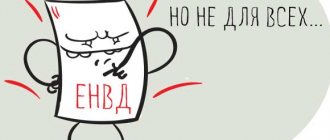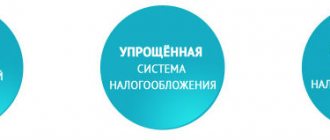The single tax on imputed income or UTII is one of the special tax regimes. When calculating this tax, it is not the taxpayer’s actual income that is taken into account, but the potential income (imputed by officials) from certain types of activities that fall under the scope of UTII.
It should be noted that in accordance with the Tax Code of the Russian Federation, potential income is assessed in physical indicators, and not in money. A physical indicator of UTII is, for example, the number of employees or the area of the sales floor.
Despite the fact that from 2021 the use of UTII for taxpayers will be abolished, throughout 2020 many entrepreneurs and LLCs will apply this special tax regime, which is optimal in terms of the size of the tax and administrative burden.
In our article we will look at the types of UTII activities in 2020, who cannot apply this tax regime, the formula for calculating the tax, as well as how to register and deregister as a payer of the Unified Tax on imputed income in 2020.
Codes of type of entrepreneurial activity UTII 2020
The types of activities falling under UTII in 2020 are as follows:
| 1. | Veterinary services |
| 2. | Household services (including services of hairdressing salons, baths, showers; photo studio services; ritual, ceremonial services; repair and construction of housing (other buildings); freight forwarding; dry cleaning, laundries; manufacturing and repair of furniture; repair and maintenance of household appliances; rental services; repair and tailoring of shoes, fur, leather, knitwear, hats and manufacturing of metal products). |
| 3. | Storage of motor vehicles in paid parking lots (except for penalty parking lots). |
| 4. | Motor transportation of passengers and cargo (if there are no more than 20 vehicles to provide such services). |
| 5. | Repair, maintenance or washing of vehicles. |
| 6. | Outdoor advertising using advertising structures. |
| 7. | Placement of advertising on vehicle surfaces (external and internal). |
| 8. | Catering services with a visitor service hall area of no more than 150 square meters (for each facility), as well as through facilities that do not have a visitor service hall. Retail trade through shops and pavilions with a sales floor area of no more than 150 square meters (for each facility); through stationary retail chain facilities that do not have sales floors; through objects of a non-stationary trading network. |
| 10. | Temporary accommodation services. Room area - up to 500 sq.m. m (for each object). |
| 11. | Leasing of land plots for the placement of stationary and non-stationary retail chain facilities; for the placement of catering facilities. |
| 12. | Leasing of stationary retail spaces that do not have sales areas; catering facilities that do not have a customer service area; objects of a non-stationary trading network. |
In order to understand the concepts: “kiosk”, “store”, “tent”, as well as “stationary” and “non-stationary retail chain”, you should read Article 346.27 of the Tax Code of the Russian Federation.
List of UTII activities
The Tax Code of the Russian Federation contains a register of types of commercial activities that allow the choice of UTII.
Let's list them:
- Provision of household services;
- Veterinary Service;
- Washing, repair and maintenance of vehicles;
- Paid car parking (excluding penalties);
- Road transportation of freight and passenger transport (if this business has no more than 20 units of equipment);
- Stationary retail trade, trading hall 150 sq. m.;
- Retail trade, in which there is no trading floor and mobile retail trade;
- Catering, with a hall for visitors also up to 150 sq. m.;
- Catering service without a hall for visitors;
- Street advertising structures;
- Advertising on transport;
- Hostels, motels, hotels, boarding houses (with a total area of up to 500 sq. m.);
- Leasing of retail outlets for stationary retail (without a sales area), mobile retail outlets and catering facilities (without a service area);
- Leasing of land for retail and catering.
Of course, officially and in more detail, types of commercial activities are listed in the All-Russian Classifier (OKVED 2). But let’s try to decipher the list in our own words:
- This is the so-called KBO (consumer services plant, operating in Soviet times), this includes the repair and production of sewing and knitted products, repair and production of shoes, hairdressers, solarium, beauty salon, repair of all types of household appliances and equipment, saunas and baths, laundry, rentals, jewelry and funeral services. Now I have added to the list (minor repairs in the house “from nail to light bulb”). This category also includes glazing of balconies, installation of doors, windows and metal fences. Another direction: art schools, tutoring, organizing holidays and matinees, various clubs, sections and gyms. And also nannies, nurses, governesses (I repeat, the list is very long);
- Veterinary clinics and pharmacies;
- Points three through seven are probably self-explanatory;
- Catering includes: cafes, restaurants, bars, canteens, snack bars (bistros), cafeterias, culinary shops, including bakery products.
Above we have listed the complete list valid in the Russian Federation. However, at the regional level, certain positions are finally formed (by decision of the municipality); for clarification, you must contact your territorial tax authority (or administration).
How to switch to UTII?
The following are not entitled to apply UTII:
1. Organizations and individual entrepreneurs who are engaged in leasing gas filling stations and gas stations. 2. Organizations and individual entrepreneurs with an average number of employees (for the previous calendar year) of more than 100 people. 3. Organizations and individual entrepreneurs that operate under a property trust management agreement or a simple partnership agreement. 4. Institutions in the field of health care, social security, education, and public catering. 5. Organizations in which the share of participation of other legal entities is more than 25% (there are some exceptions here). 6. Organizations belonging to the category of “largest taxpayers”. 7. Organizations and individual entrepreneurs selling goods subject to mandatory labeling.
You can switch to UTII in 2020 on a voluntary basis. To do this you must submit an application:
- according to the UTII-1 form - for organizations;
- according to the UTII-2 form - for individual entrepreneurs.
An application for transition to the Unified Tax on Imputed Income must be submitted within five working days from the date of commencement of business activities. If this deadline is violated, the fine will be 10,000 rubles.
The document must be submitted to the tax service:
- at place of residence - for individual entrepreneurs;
- by location - for organizations.
Within five days from the date of filing the application at the tax office, the entrepreneur will be given a notice of registration as a UTII payer.
Please note that the transition from UTII to other tax regimes is possible only from the next calendar year. At the same time, the Tax Code of the Russian Federation states that it is possible to switch to the Simplified taxation system from the beginning of the month in which activities on UTII were terminated.
UTII
This is one of the types of special modes. The tax is classified as “regional”, since it begins to operate only on the basis of decisions of municipalities (as Moscow did and abolished in 14).
A special tax regime, and in particular a single tax, was introduced to simplify the accounting of small and micro enterprises. Since 2013, the choice of UTII occurs at the merchant’s own request. Both companies use UTII.
The use of UTII exempts your business from paying income tax, property tax and VAT; other taxes and contributions are paid without changes.
The tax rate is in no way aligned with your actual income. The exact name of UTII: a single tax on imputed income for certain types of activities (where the key word is “separate”). Therefore, let's figure out what kind of activity a businessman can choose to use UTII.
Formula for calculating UTII
In order to calculate UTII, you must use the following formula:
UTII = Basic profitability x Physical indicator x K1 x K2×15%.
The basic profitability per unit of physical indicator is established by the state. It depends on the type of business activity. The physical indicator for each type of activity is separate. This could be the number of square meters of premises, or the number of employees.
K1 - the deflator coefficient is set for the calendar year by the Ministry of Economic Development of the Russian Federation. For 2020, the coefficient is 2.009.
K2 - correction factor. It is established by municipal authorities (in order to reduce the amount of UTII tax) for certain types of activities. The value of the coefficient can be found on the Federal Tax Service website.
It is worth considering that starting from October 1, 2020, local authorities have the right to change the tax rate for UTII. Thus, the tax amount can vary from 7.5 to 15 percent. It depends on the type of business activity.
Types of activities for which the transition to UTII is allowed in 2020
According to Article 346.26, paragraph 2 of the Tax Code of the Russian Federation, legal entities and individual entrepreneurs who provide any services to the population or are engaged in retail trade can switch to imputed income. In this article of the tax code, all parameters are regulated.
So:
- An entrepreneur, organizing the transportation of passengers or goods, may own no more than 20 vehicles.
- When organizing retail trade, the area of the sales floor should not exceed 150 m².
- When providing household services to the population, it follows the standards approved by the Government of the Russian Federation.
Household services are classified according to Order of the Government of the Russian Federation dated November 24, 2016 No. 2496-r. It contains activity codes for UTII according to OKVED.
How to calculate the tax amount for UTII
The Tax Code of the Russian Federation in Article 346.29 specifies the formula by which the imputed tax is calculated.
Basic Yield (BD)×Physical Indicator (FP)×K-1 (coefficient – deflator)×K-2 (reducing factor)×15% = amount to be paid UTII for the month.
In this formula, DB, FP and K-1 do not have a regional link. K-2 is approved by the regions. It depends on municipal regulations.
By Order of the Ministry of Economic Development No. 739 dated October 21, 2019, the K-1 coefficient for 2020 was set at 2.005.
This formula is deciphered as follows:
- BD – calculated in rubles, per unit of physical indicator;
- FP - corresponds to the number of employees or m² of sales floor and other indicators depending on the type of activity;
- K-1 – regulated by order of the Ministry of Economic Development of the Russian Federation, annually;
- K-2 – regulated annually by local municipal authorities.
The K-2 coefficient is found out at the Federal Migration Service at the place of registration of the enterprise or individual entrepreneur.
K-2 may differ for retail outlets located on different streets of the same municipality.
Conditions for the transition of LLCs and individual entrepreneurs to UTII
In accordance with the Tax Code of the Russian Federation in Article 346.26, a mandatory condition for switching to imputed tax for legal entities is:
- the share of other legal entities should not exceed 25% of the authorized capital of the company;
- the company has less than 100 employees on staff;
- the company does not lease gas stations;
- does not sell at retail excisable goods subject to mandatory labeling, as well as identification marks;
- is not a major taxpayer in the region.
For an individual entrepreneur:
- number of employees up to 100 people.
- does not lease gas stations;
- does not sell excisable goods;
- does not sell goods subject to mandatory labeling;
- does not implement identification marks.
Deadlines for submitting reports and paying taxes on UTII in 2020
The tax return is submitted to the tax office electronically, by mail or in person, quarterly. The due date is limited to the 20th day inclusive, the month following the reporting quarter.
When sending reports through the post office, the postmark must be no later than the 20th.
Tax payment is made no later than 5 days after submitting the declaration. Imputed tax is paid even if the enterprise or entrepreneur did not conduct activities during the reporting period. Penalties are provided for late payment of UTII tax.
Regional features of UTII
The above list can be considered as types of activities recommended by the state for the application of a single tax for entrepreneurs and firms operating in these areas. However, it is not at all a direct guide to action throughout the country. Thus, small businesses operating in the capital of our homeland are generally deprived of the opportunity to use this regime: until the beginning of 2012, a single tax was provided for only one type of activity - placing outdoor advertising. Then the Moscow authorities decided to grant the right to apply UTII for certain types of businesses in the territories newly annexed to the city, but only temporarily. From January 1, 2014, no types of activities are available for UTII in Moscow.
All other regions of the Russian Federation have the same freedom of action. The state gives each entity the right to independently determine which services it considers appropriate to impose a single tax on imputed income. Thus, local authorities have the opportunity to regulate the services market by providing some tax breaks to certain taxpayers. Moreover, previously the transfer to “imputation” was forced: if the activities of a small business entity fell under UTII, he had no other choice but to work according to this scheme. Since 2013, this regime has become voluntary: an entrepreneur is not obliged to become a UTII payer if it is not profitable for him.
Municipalities and district authorities can choose any number of types of activities - one, several or all - for the transition of entrepreneurs to “imputation”. Naturally, “amateur activity” at the local level is limited to the list permitted by tax legislation (Chapter 26.3 of the Tax Code), and no other services not included in it can be transferred to UTII.
It is also within the competence of local authorities to set a correction coefficient (K2) for each type of “imputed” work and services. The basic profitability itself is set at the legislative level, as well as the tax rate (15%). The Government of the Russian Federation annually determines the value of the deflator coefficient (K1), which is used by all “imputers” when calculating taxes.
Payers
Business entities that meet the criteria specified in the legislation have the right to choose a special taxation system.
All types of activities on UTII in 2020 for individual entrepreneurs are specified in the Tax Code of the Russian Federation and are adjusted by decisions of regional authorities:
- Satisfying the household needs of the population.
- Treatment of animals.
- Car repair services, including cleaning.
- Transportation of people and goods.
- Piece sales of goods in premises up to 150 square meters. m.
- Retail trade in permanent and mobile networks.
- Renting out parking areas. This includes ensuring machine safety.
- Catering services with a department for visitors up to 150 sq. m. or without a special room.
- Outdoor advertising on devices and vehicles.
- Hotel activities and rental housing up to 500 square meters. m.
- Rent of retail outlets and land plots for retail and catering.
Each item has a detailed description in accordance with the OKVED and OKP codes. In addition, there are codes for the types of entrepreneurial activities of UTII, which are used when filling out the imputed regime payer registration form, deregistration and drawing up a tax return.
When receiving individual entrepreneur status, the applicant correlates his type of business transactions with information from the classifier. If these numbers are in the permit list of local legislation, and all other necessary conditions are met, then the payer has the right to UTII.
The capital of Russia has established a ban on the operation of the imputed regime in the city since 2014.





